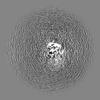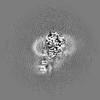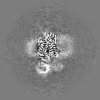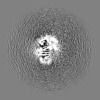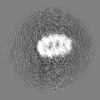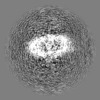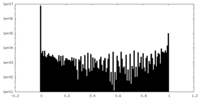+ Open data
Open data
- Basic information
Basic information
| Entry |  | |||||||||
|---|---|---|---|---|---|---|---|---|---|---|
| Title | Human resource SGLT1-MAP17 complex | |||||||||
 Map data Map data | ||||||||||
 Sample Sample |
| |||||||||
 Keywords Keywords | Complex / MEMBRANE PROTEIN | |||||||||
| Biological species |  | |||||||||
| Method | single particle reconstruction / cryo EM / Resolution: 3.3 Å | |||||||||
 Authors Authors | Chen L / Zhang XZ | |||||||||
| Funding support |  China, 1 items China, 1 items
| |||||||||
 Citation Citation |  Journal: Sci Adv / Year: 2024 Journal: Sci Adv / Year: 2024Title: Correction of preferred orientation-induced distortion in cryo-electron microscopy maps. Authors: Dongjie Zhu / Weili Cao / Junxi Li / Chunling Wu / Duanfang Cao / Xinzheng Zhang /  Abstract: Reconstruction maps of cryo-electron microscopy (cryo-EM) exhibit distortion when the cryo-EM dataset is incomplete, usually caused by unevenly distributed orientations. Prior efforts had been ...Reconstruction maps of cryo-electron microscopy (cryo-EM) exhibit distortion when the cryo-EM dataset is incomplete, usually caused by unevenly distributed orientations. Prior efforts had been attempted to address this preferred orientation problem using tilt-collection strategy and modifications to grids or to air-water interfaces. However, these approaches often require time-consuming experiments, and the effect was always protein dependent. Here, we developed a procedure containing removing misaligned particles and an iterative reconstruction method based on signal-to-noise ratio of Fourier component to correct this distortion by recovering missing data using a purely computational algorithm. This procedure called signal-to-noise ratio iterative reconstruction method (SIRM) was applied on incomplete datasets of various proteins to fix distortion in cryo-EM maps and to a more isotropic resolution. In addition, SIRM provides a better reference map for further reconstruction refinements, resulting in an improved alignment, which ultimately improves map quality and benefits model building. | |||||||||
| History |
|
- Structure visualization
Structure visualization
| Supplemental images |
|---|
- Downloads & links
Downloads & links
-EMDB archive
| Map data |  emd_39299.map.gz emd_39299.map.gz | 28.7 MB |  EMDB map data format EMDB map data format | |
|---|---|---|---|---|
| Header (meta data) |  emd-39299-v30.xml emd-39299-v30.xml emd-39299.xml emd-39299.xml | 11.9 KB 11.9 KB | Display Display |  EMDB header EMDB header |
| Images |  emd_39299.png emd_39299.png | 50.4 KB | ||
| Masks |  emd_39299_msk_1.map emd_39299_msk_1.map | 30.5 MB |  Mask map Mask map | |
| Filedesc metadata |  emd-39299.cif.gz emd-39299.cif.gz | 3.8 KB | ||
| Others |  emd_39299_half_map_1.map.gz emd_39299_half_map_1.map.gz emd_39299_half_map_2.map.gz emd_39299_half_map_2.map.gz | 28.2 MB 28.2 MB | ||
| Archive directory |  http://ftp.pdbj.org/pub/emdb/structures/EMD-39299 http://ftp.pdbj.org/pub/emdb/structures/EMD-39299 ftp://ftp.pdbj.org/pub/emdb/structures/EMD-39299 ftp://ftp.pdbj.org/pub/emdb/structures/EMD-39299 | HTTPS FTP |
-Validation report
| Summary document |  emd_39299_validation.pdf.gz emd_39299_validation.pdf.gz | 741.9 KB | Display |  EMDB validaton report EMDB validaton report |
|---|---|---|---|---|
| Full document |  emd_39299_full_validation.pdf.gz emd_39299_full_validation.pdf.gz | 741.5 KB | Display | |
| Data in XML |  emd_39299_validation.xml.gz emd_39299_validation.xml.gz | 10.7 KB | Display | |
| Data in CIF |  emd_39299_validation.cif.gz emd_39299_validation.cif.gz | 12.4 KB | Display | |
| Arichive directory |  https://ftp.pdbj.org/pub/emdb/validation_reports/EMD-39299 https://ftp.pdbj.org/pub/emdb/validation_reports/EMD-39299 ftp://ftp.pdbj.org/pub/emdb/validation_reports/EMD-39299 ftp://ftp.pdbj.org/pub/emdb/validation_reports/EMD-39299 | HTTPS FTP |
-Related structure data
- Links
Links
| EMDB pages |  EMDB (EBI/PDBe) / EMDB (EBI/PDBe) /  EMDataResource EMDataResource |
|---|
- Map
Map
| File |  Download / File: emd_39299.map.gz / Format: CCP4 / Size: 30.5 MB / Type: IMAGE STORED AS FLOATING POINT NUMBER (4 BYTES) Download / File: emd_39299.map.gz / Format: CCP4 / Size: 30.5 MB / Type: IMAGE STORED AS FLOATING POINT NUMBER (4 BYTES) | ||||||||||||||||||||||||||||||||||||
|---|---|---|---|---|---|---|---|---|---|---|---|---|---|---|---|---|---|---|---|---|---|---|---|---|---|---|---|---|---|---|---|---|---|---|---|---|---|
| Projections & slices | Image control
Images are generated by Spider. | ||||||||||||||||||||||||||||||||||||
| Voxel size | X=Y=Z: 1.167 Å | ||||||||||||||||||||||||||||||||||||
| Density |
| ||||||||||||||||||||||||||||||||||||
| Symmetry | Space group: 1 | ||||||||||||||||||||||||||||||||||||
| Details | EMDB XML:
|
-Supplemental data
-Mask #1
| File |  emd_39299_msk_1.map emd_39299_msk_1.map | ||||||||||||
|---|---|---|---|---|---|---|---|---|---|---|---|---|---|
| Projections & Slices |
| ||||||||||||
| Density Histograms |
-Half map: #1
| File | emd_39299_half_map_1.map | ||||||||||||
|---|---|---|---|---|---|---|---|---|---|---|---|---|---|
| Projections & Slices |
| ||||||||||||
| Density Histograms |
-Half map: #2
| File | emd_39299_half_map_2.map | ||||||||||||
|---|---|---|---|---|---|---|---|---|---|---|---|---|---|
| Projections & Slices |
| ||||||||||||
| Density Histograms |
- Sample components
Sample components
-Entire : SGLT1-MAP17
| Entire | Name: SGLT1-MAP17 |
|---|---|
| Components |
|
-Supramolecule #1: SGLT1-MAP17
| Supramolecule | Name: SGLT1-MAP17 / type: complex / ID: 1 / Parent: 0 |
|---|---|
| Source (natural) | Organism:  |
-Experimental details
-Structure determination
| Method | cryo EM |
|---|---|
 Processing Processing | single particle reconstruction |
| Aggregation state | particle |
- Sample preparation
Sample preparation
| Buffer | pH: 7.5 |
|---|---|
| Vitrification | Cryogen name: ETHANE |
- Electron microscopy
Electron microscopy
| Microscope | FEI TITAN KRIOS |
|---|---|
| Image recording | Film or detector model: GATAN K3 (6k x 4k) / Average electron dose: 37.6 e/Å2 |
| Electron beam | Acceleration voltage: 300 kV / Electron source:  FIELD EMISSION GUN FIELD EMISSION GUN |
| Electron optics | Illumination mode: FLOOD BEAM / Imaging mode: BRIGHT FIELD / Nominal defocus max: 1.8 µm / Nominal defocus min: 1.4000000000000001 µm |
| Experimental equipment |  Model: Titan Krios / Image courtesy: FEI Company |
- Image processing
Image processing
| Startup model | Type of model: EMDB MAP EMDB ID: |
|---|---|
| Final reconstruction | Applied symmetry - Point group: C1 (asymmetric) / Resolution.type: BY AUTHOR / Resolution: 3.3 Å / Resolution method: FSC 0.143 CUT-OFF / Software - Name: cryoSPARC (ver. 4.1.1) / Number images used: 280215 |
| Initial angle assignment | Type: MAXIMUM LIKELIHOOD |
| Final angle assignment | Type: MAXIMUM LIKELIHOOD |
 Movie
Movie Controller
Controller



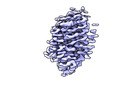







 Z (Sec.)
Z (Sec.) Y (Row.)
Y (Row.) X (Col.)
X (Col.)







